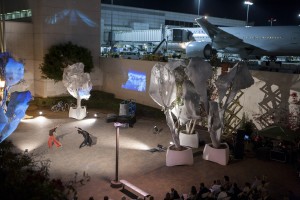[A version of this piece originally ran on the L.A. Weekly arts blog.]
The current renovations and re-branding of Los Angeles International Airport is delivering frustrating, mixed cues for its art. In its first public arts festival — “Influx: Art at LAX,” running through Dec. 31 — a few of the newly designed and curated exhibition spaces — as well as Sarah Elgart’s Everywhere Nowhere performance piece, held this past weekend — had enough firepower to wrest one’s attention from the immensity and chaos of airport commerce. Yet others lost out, sometimes unnecessarily so.
It’s just such a muddling environment. The monochromatic, artificial tone of new airport construction helps signal modern art aesthetics, yet the beastly sprawl and terrarium light denies it sanctity or formalism of the white-cube gallery.
Some small adaptations helped a lot. Near the red Virgin counters in Terminal 3, frosted glass was installed in doors and windows to soften the light on Eileen Cowin’s video work, Blow Me a Kiss, and her bank of expressive, gesturing faces seems to glow from inner emotion. Yet whose idea was it to install three huge full-color AT&T banner ads in the same atrium as Barbara Strasen’s horizontal banks of lenticular panels, Flow and Glimpse? Strasen’s carefully crafted undulations, meant to carry a weary soul through Terminal 2’s security checkpoint, were practically obliterated by those competing ad panels. (And two smaller sets of panels, running alongside the ascending escalators, aren’t easily read because the escalators are keyed to move too quickly.)
If there’s no handle on advertising placards at LAX, super-sized video installations like See Change, which was unveiled in June 2012 in the arrivals area of the new Tom Bradley Internationalal Terminal, will surely come to dominate all terminals. Yet at this point Los Angeles World Airports is trying a little bit of everything — hijacking under-used corridors and setting works into dead spaces within larger atriums.
Of all the accessible public works (half of the 11 sites are restricted to ticketed passengers), keep an eye out for “Levitational,” the show John David O’Brien curated in the long hallway between baggage claim areas in Terminals 2 and 3, which will hang for 6 months or so. The space could use more design and lighting improvements, but little mysteries and treasures abound, like Rebecca Ripple’s captured steel cloud and Daniel Brodo’s mechanical chime-and-feather overhead pulley. Over in Terminal 3, an outsized expression of this kind of gentle suspension is also visible in Joyce Dallal’s Elevate, a bipartite flock of spired birds installed in two huge window bays by the security checkpoint.
Given the interior constraints of LAX, choreographer/director Elgart had it easiest, in a way, as she could build a moody, night-lit exterior performance environ from scratch with her crackerjack team of sound and visual designers (composer Yuval Ron, production designer Stephen Glassman, projections and lighting by Kevin Kerslake, costumes by Swinda Reichert).
Set on an open plaza against an exterior wall of Terminal 2 (the word “courtyard” in the press materials was a generous term for the massive dead space between two buildings, right alongside the arrivals traffic route), Everywhere Nowhere touched down inside a grove of cloth-wrapped trees and white walls, alit by projections from at least three sources: images of birds filled the trees, an underwater horse swimming on one wall, and a night-driving highway scene on the high wall above the stage. The opening movement sequence (and its later variations) was strong and fresh: Into this wild, flickering hush emerged 10 idiosyncratic camera-ready male and female dancers, in a trailing line, galumphing with their legs high and heads down.
This is Elgart’s third piece for Los Angeles World Airports on the subject of journeying, but her first at LAX, and she returned to familiar themes (pumping birds’ wings) as well as honoring this particular site, with evocations of immigrant arrivals, celebrity struts, and a blooming female cocoon.
More director than choreographer, Elgart built masterful visuals with simple props: some suitcases, a oversized bale of straw, or an airport cherry picker draped with a long train of silk, but the movement phrases lacked development (we got: writhing, slumping, gnarling, repeat). Why was there no use of pedestrian movement? Why so much pre-chewed full-bodied struts and kicks? Her bodies don’t seem to match her mood.
Yet changing textures were etched beautifully by Yuval’s pumping world-fusion score and Kerslake’s video projections, most crucially that recurring image of headlights on blacktop illuminating a slanting, driving rain,one of those moments in travel when you’re stilled — everywhere nowhere — inside the act of navigating.
